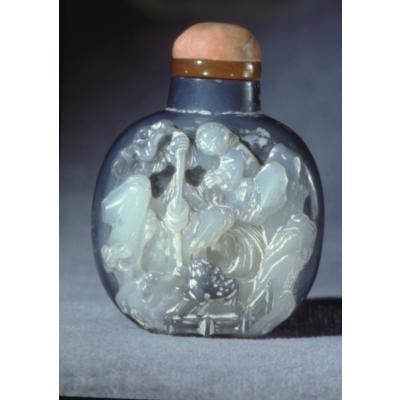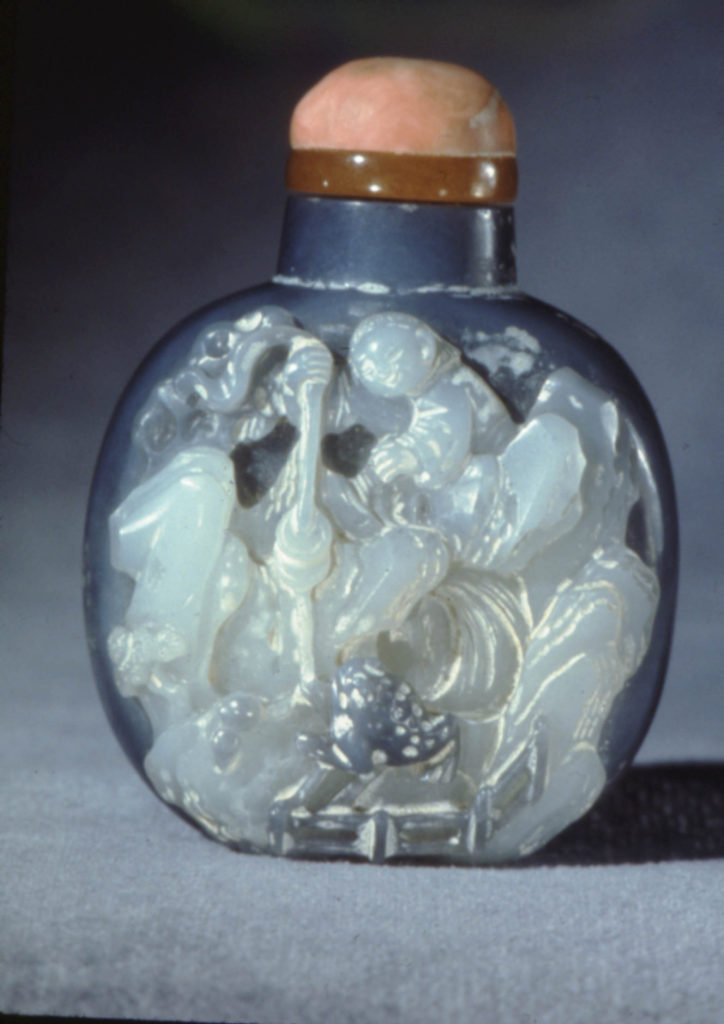
Posted in: Exhibitions
 On view at the Elizabeth Hubert Malott Hall of Jades, this exquisite carved jade snuff bottle. Decorated snuff bottles grew in popularity during the Qing period in China. Photo courtesy Field Museum, Chicago.
In the Elizabeth Hubert Malott Hall of Jades, the Field Museum of Chicago invites visitors to take a journey through the history of jade. Spanning the millennia between Neolithic burial rituals and today's contemporary artists, over 450 jade objects tell the intricate story of what happens when a stone ceases to be a mere stone.
On view at the Elizabeth Hubert Malott Hall of Jades, this exquisite carved jade snuff bottle. Decorated snuff bottles grew in popularity during the Qing period in China. Photo courtesy Field Museum, Chicago.
In the Elizabeth Hubert Malott Hall of Jades, the Field Museum of Chicago invites visitors to take a journey through the history of jade. Spanning the millennia between Neolithic burial rituals and today's contemporary artists, over 450 jade objects tell the intricate story of what happens when a stone ceases to be a mere stone.
The Fairest Stone
For more than 8,000 years, the Chinese have revered jade, not only for its beauty but also for its strength. Today, jade embodies the highest of Chinese virtues - Wisdom, Courage, Benevolence, Integrity, and Loyalty. In the Hall of Jades, visitors walk the timeline of Chinese history, beginning with burial objects dating back to 4100 BC. At that time, tools and weapons carved from jade accompanied the dead. Even that far back in time, jade marked a person's rank and status. Those of highest rank traveled into the afterlife surrounded by an abundance of jade objects. Rooted in shamanic beliefs, jade ensured immortality to anyone who wore it in death. By the time of the Han dynasty, the Chinese commonly buried their elite in full suits of jade armor, held together by thread made of gold or silver wire. Not only to confer immortality, but also safe passage through the realms of evil spirits. One such suit of armor remains on permanent display in the Hall of Jades. Indeed, this jade armor dates back to the Han dynasty. According to an academic paper written by James Stola, this particular Chinese practice calls to mind the use of jade in many other cultures, as well. (source)Jade Around the World
Indeed, jade is found on every continent in the world. Furthermore, on every continent at least one indigenous people group used jade to fashion relics, tools, or ornamental jewelry. In the Americas, the Mayans crafted elaborate funerary masks for their fallen rulers. They also placed a jade bead in the mouths of their dead. In China, during the Chou dynasty, a custom involved the placement of a carved jade cicada in the mouth of those who passed. Meanwhile, back in North America, the indigenous people of Northwestern Alaska carved tools out of jade. The Aztecs fashioned jades into ornaments, jewelry, and ritual art associated with immortality and the mystical elements of the earth - air, water, fire, and earth. In New Zealand, the Maori carved jades into tools and ornaments. And Europeans have revered jade for more than 6,000 years. Jade not only connects people across cultural boundaries, it also unifies the disciplines of science.An Integration of All Science*
Once again, I reference the paper written by James Stola. He discusses the importance of the Hall of Jades as an opportunity to witness how every scientific discipline of Natural History influences Cultural Anthropology. As peoples discover natural geological resources, they create new techniques and technologies to fashion those resources into useful objects for life. In the Hall of Jades, we see the fusion of geology, metallurgy, and anthropology and how this fusion both defined and shaped different cultures across time. In terms of geology, the Hall of Jades also examines the many manifestations of jade in the natural world. Of course, you are familiar with the verdant green jadeite synonymous with Chinese jade. However, even in China jade emerges in a wide range of colors. The second most common of these is the gray-green nephrite jade. In fact, nephrite and jadeite are two distinctive species of jade. Both species actually come in many colors, including purple and lavender, blue and light blue, yellow, reddish-orange, and brown. A particularly coveted color in China is mutton fat, which is white nephrite, as pictured in the above photo. All of this and more awaits you in the Hall of Jades at Chicago's Field Museum. Visit their website for all the details you need to plan your trip. ~Angela Magnotti Andrews *This is a quote from the academic paper written by James Stola. Click here to read his paper on the Hall of Jades.5 years ago
2 view(s) 